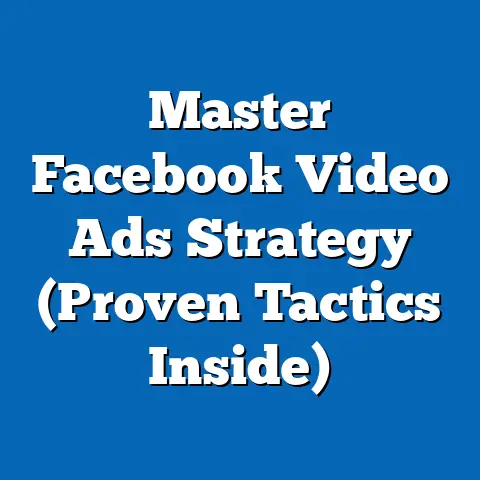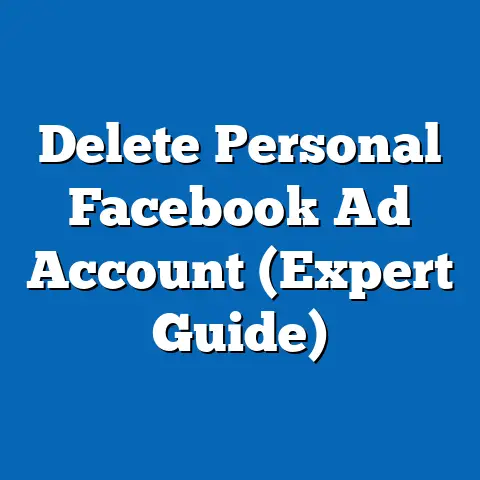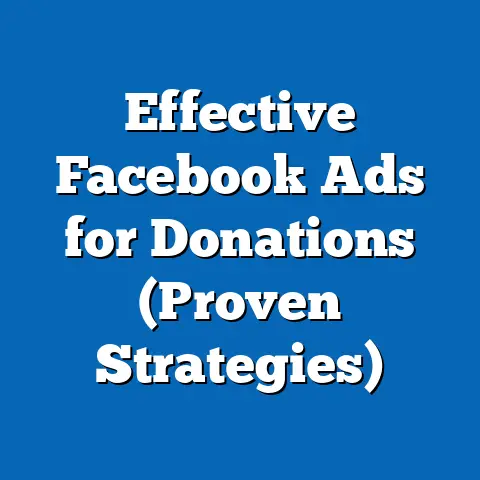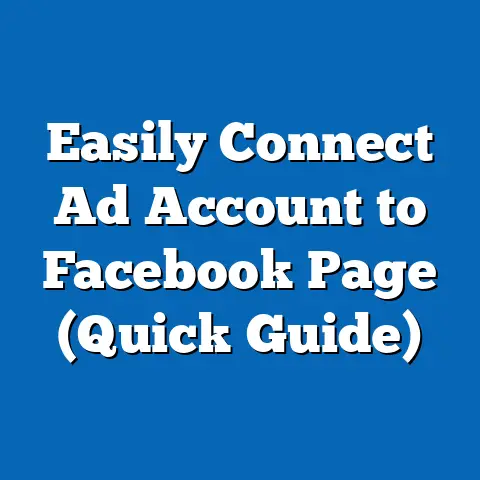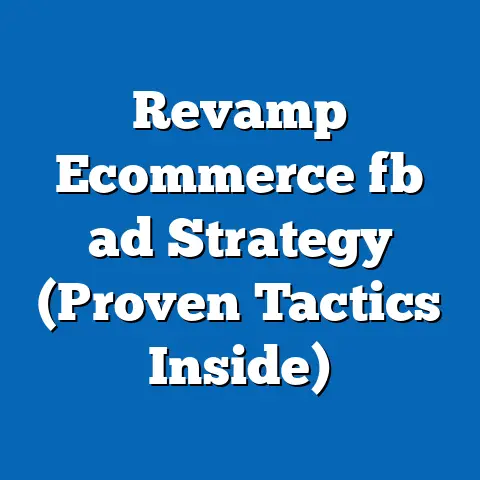Remove Cards on Facebook Ads (Ultimate Step-by-Step Guide)
In today’s digital advertising landscape, businesses are increasingly aware of the impact their marketing strategies have on the environment. It’s not just about reaching the target audience; it’s about doing so responsibly and efficiently. I’ve seen a shift in the industry where brands are looking for ways to align their advertising with sustainable practices, and one area where this can be applied is in streamlining Facebook ads.
As part of a broader commitment to reducing digital clutter and enhancing user experience, advertisers often need to refine their Facebook ads by removing unnecessary cards or elements. Think of it as Marie Kondo-ing your digital marketing – keeping what sparks joy (or in this case, drives results) and letting go of what doesn’t. This isn’t just about aesthetics; it’s about making your ads more effective, engaging, and eco-conscious.
Section 1: Understanding Facebook Ads and Cards
Before we jump into the how-to, let’s make sure we’re all on the same page about what Facebook ads and cards actually are.
What are Facebook Ads?
Facebook advertising is a powerful tool that allows businesses to reach a vast and diverse audience on the world’s largest social media platform. It enables you to target specific demographics, interests, and behaviors, making it incredibly effective for reaching potential customers.
I remember when I first started using Facebook ads, I was amazed by the level of granularity you could achieve with targeting. You could literally show an ad to people who liked a specific band, lived in a particular zip code, and had an interest in hiking. This level of precision is what makes Facebook advertising such a significant part of digital marketing strategies for businesses of all sizes.
Facebook ads come in various formats, including images, videos, carousels, and more. They appear in users’ news feeds, stories, and even within Messenger. The goal is to capture attention, drive engagement, and ultimately, achieve your business objectives, whether that’s increasing brand awareness, generating leads, or driving sales.
What are Cards in Facebook Ads?
Now, let’s talk about “cards.” In the context of Facebook ads, cards typically refer to the individual elements within a carousel ad format. A carousel ad allows you to showcase multiple images or videos in a single ad unit, each with its own headline, description, and call-to-action. Each of these individual elements is what we call a “card.”
Think of it like a digital slideshow where each slide tells a different part of your story or showcases a different product. I’ve found carousel ads to be particularly effective for e-commerce businesses, as they allow you to display multiple products in a visually appealing and engaging way.
However, cards aren’t limited to just carousel ads. They can also refer to the different components within a single image or video ad, such as the headline, description, and call-to-action button. Each of these elements plays a crucial role in the overall effectiveness of your ad.
Why Remove Cards?
You might be wondering, “Why would I want to remove cards from my Facebook ads?” There are several valid reasons:
- Improving User Engagement: Sometimes, less is more. Too many cards in a carousel ad can overwhelm users and lead to lower engagement rates. By removing unnecessary or underperforming cards, you can simplify the ad structure and focus on the most compelling content.
- Simplifying the Ad Structure: A cluttered ad can be confusing and distracting. By removing redundant or ineffective cards, you can create a cleaner, more focused ad that clearly communicates your message.
- Making Eco-Conscious Choices: This might seem like a stretch, but it’s a perspective I encourage. By reducing digital clutter, you’re contributing to a more efficient and sustainable digital ecosystem. Every image, video, and piece of data consumes energy, so minimizing unnecessary elements can have a small but positive impact.
I’ve personally experienced situations where removing a card from a carousel ad actually improved the overall performance. In one instance, I was running a carousel ad for a client’s clothing store, and one of the cards was showcasing a product that wasn’t very popular. After removing that card, the click-through rate and conversion rate of the ad increased significantly.
Key Takeaway: Understanding the purpose of Facebook ads and the role of cards within them is crucial for making informed decisions about your advertising strategy. Removing unnecessary cards can lead to improved user engagement, a simplified ad structure, and even contribute to a more eco-conscious approach to digital marketing.
Section 2: Preparing to Remove Cards
Before you start deleting cards left and right, it’s important to take a step back and do some preparation. This will ensure that you’re making informed decisions and not just blindly removing elements that might actually be contributing to your ad’s success.
Evaluating Your Current Ads
The first step is to assess your current Facebook ads and identify which cards are unnecessary or underperforming. This involves analyzing your ad performance metrics, such as:
- Click-Through Rate (CTR): This measures the percentage of people who saw your ad and clicked on it. A low CTR could indicate that the card isn’t engaging enough.
- Conversion Rate: This measures the percentage of people who took a desired action (e.g., made a purchase, filled out a form) after clicking on your ad. A low conversion rate could indicate that the card isn’t effectively driving results.
- Engagement Rate: This measures the level of interaction your ad is receiving, such as likes, comments, and shares. Low engagement could indicate that the card isn’t resonating with your target audience.
I recommend using Facebook Ads Manager to track these metrics and identify any cards that are consistently underperforming. Pay close attention to cards that have a low CTR, low conversion rate, and low engagement rate. These are the prime candidates for removal.
Setting Goals for Your Ads
Before you start making changes to your ads, it’s important to have clear objectives for your advertising strategy. What are you trying to achieve with your ads? Are you trying to increase brand awareness, generate leads, or drive sales?
Having clear goals will help guide your decision-making process when it comes to removing cards. For example, if your goal is to drive sales, you might want to remove cards that aren’t directly contributing to conversions. On the other hand, if your goal is to increase brand awareness, you might want to focus on removing cards that aren’t visually appealing or engaging.
Gathering Necessary Tools
To effectively manage your Facebook ads and remove cards, you’ll need access to the following tools and resources:
- Facebook Ads Manager: This is the primary tool for creating, managing, and analyzing your Facebook ads.
- Analytics Tools: In addition to Facebook Ads Manager, you might want to use other analytics tools, such as Google Analytics, to track your ad performance and identify areas for improvement.
- Design Software: If you need to create new images or videos for your ads, you’ll need access to design software, such as Adobe Photoshop or Canva.
Key Takeaway: Preparing to remove cards involves evaluating your current ads, setting clear goals, and gathering the necessary tools. By taking these steps, you’ll be well-equipped to make informed decisions and optimize your Facebook advertising strategy.
Here’s a detailed, step-by-step guide on how to remove cards from your Facebook ads:Step 1: Log into Facebook Ads Manager
The first step is to access Facebook Ads Manager. Here’s how:
- Go to www.facebook.com/adsmanager.
- Log in using your Facebook account credentials.
- If you have multiple ad accounts, select the one you want to work with.
Navigating the interface can be a bit overwhelming at first, but don’t worry, you’ll get the hang of it. The main sections you’ll need to be familiar with are the Campaigns, Ad Sets, and Ads tabs.
Step 2: Select the Campaign and Ad Set
Once you’re in Facebook Ads Manager, you need to locate the specific campaign and ad set that contains the ad you want to edit. Here’s how:
- Click on the “Campaigns” tab.
- Select the campaign that contains the ad you want to edit.
- Click on the “Ad Sets” tab.
- Select the ad set that contains the ad you want to edit.
Step 3: Edit the Ad
Now that you’ve found the right ad set, it’s time to select the ad and enter the editing mode. Here’s how:
- Click on the “Ads” tab.
- Select the ad you want to edit.
- Click on the “Edit” button. This will open the ad editing interface.
Step 4: Identify the Cards to Remove
This is where your analysis from Section 2 comes into play. You need to carefully examine the ad and identify which cards are redundant or ineffective.
- Carousel Ads: For carousel ads, look at the performance metrics for each individual card. Which cards have the lowest CTR, conversion rate, and engagement rate? These are the ones you should consider removing.
- Single Image or Video Ads: For single image or video ads, think about the different elements of the ad, such as the headline, description, and call-to-action. Are any of these elements not contributing to the overall effectiveness of the ad? Could the message be more concise and impactful without a particular element?
I often use a simple spreadsheet to track the performance metrics of each card in a carousel ad. This helps me visualize the data and quickly identify the underperformers.
Step 5: Remove the Cards
Now for the actual removal process. The exact steps will vary depending on the type of ad you’re working with:
- Carousel Ads:
- In the ad editing interface, scroll down to the “Carousel Cards” section.
- Hover over the card you want to remove.
- Click on the “Delete” icon (usually a trash can).
- Confirm that you want to remove the card.
- Single Image or Video Ads:
- In the ad editing interface, locate the element you want to remove (e.g., headline, description).
- Delete the text or content from that element.
- If you want to remove the call-to-action button, you can select “No Button” from the “Call to Action” dropdown menu.
- In the ad editing interface, scroll down to the “Carousel Cards” section.
- Hover over the card you want to remove.
- Click on the “Delete” icon (usually a trash can).
- Confirm that you want to remove the card.
- In the ad editing interface, locate the element you want to remove (e.g., headline, description).
- Delete the text or content from that element.
- If you want to remove the call-to-action button, you can select “No Button” from the “Call to Action” dropdown menu.
Step 6: Preview and Save Changes
Before you finalize your changes, it’s crucial to preview the ad to make sure everything looks the way you want it to.
- In the ad editing interface, click on the “Preview” button.
- Review the ad on different devices and placements to ensure it looks good on all platforms.
- If you’re satisfied with the changes, click on the “Publish” button to save your updated ad.
I always double-check my work before publishing any changes. It’s easy to make a mistake, and you don’t want to accidentally delete something important.
Step 7: Monitor Performance Post-Changes
The job isn’t done once you’ve removed the cards and published your changes. You need to monitor the ad’s performance to see if the changes have had the desired effect.
- Track Key Metrics: Keep a close eye on your CTR, conversion rate, and engagement rate.
- Compare to Baseline: Compare your post-change performance to your pre-change performance. Are you seeing an improvement in your key metrics?
- Make Further Adjustments: If you’re not seeing the results you want, don’t be afraid to make further adjustments to your ad. You might need to remove additional cards, experiment with different messaging, or adjust your targeting.
Key Takeaway: Removing cards from Facebook ads is a straightforward process, but it requires careful planning and execution. By following these step-by-step instructions, you can effectively streamline your ads and improve their performance.
Section 4: Best Practices After Removing Cards
Once you’ve removed the unnecessary cards from your Facebook ads, it’s important to implement some best practices to ensure that your ads continue to perform well.
Testing and Optimization
A/B testing, also known as split testing, is a crucial part of any successful advertising strategy. It involves creating multiple versions of your ad with slight variations and then testing them against each other to see which one performs best.
After removing cards from your ads, I strongly recommend running A/B tests to assess the impact of the changes. For example, you could test different headlines, descriptions, or call-to-action buttons to see which ones resonate most with your target audience.
Facebook Ads Manager makes it easy to create and run A/B tests. Simply create a duplicate of your ad, make the desired changes, and then set up an A/B test to compare the performance of the two ads.
Engaging with Your Audience
Just because you’ve removed some cards from your ads doesn’t mean you should compromise on engagement. In fact, it’s more important than ever to create compelling content that captures attention and drives interaction.
Here are some strategies for maintaining audience engagement without the additional cards:
- Use Compelling Visuals: High-quality images and videos are essential for capturing attention and conveying your message effectively.
- Write Strong Calls to Action: Your call-to-action should be clear, concise, and persuasive. Tell people exactly what you want them to do.
- Craft Concise Messaging: Get straight to the point and communicate your message in a clear and concise manner. Avoid jargon and use language that your target audience will understand.
- Ask Questions: Encourage interaction by asking questions in your ad copy. This can be a great way to spark conversation and build relationships with your audience.
Staying Updated on Facebook Ads Features
Facebook is constantly evolving, and new features and updates are being released all the time. To stay ahead of the curve, it’s important to stay informed about the latest changes and how they can impact your advertising strategy.
I recommend subscribing to the Facebook Ads blog, following industry experts on social media, and attending webinars and conferences to stay up-to-date on the latest trends and best practices.
Key Takeaway: Removing cards is just one step in the process of optimizing your Facebook ads. By implementing these best practices, you can ensure that your ads continue to perform well and achieve your business objectives.
Conclusion
Removing unnecessary cards from your Facebook ads is a simple but effective way to improve their performance, simplify your ad structure, and even contribute to a more eco-conscious approach to digital marketing.
By following the step-by-step guide outlined in this article, you can effectively streamline your ads and achieve better engagement and effectiveness in a sustainable manner. Remember to evaluate your current ads, set clear goals, gather the necessary tools, and monitor your performance post-changes.
I encourage you to take action today by applying the steps outlined in this guide and continuing to refine your advertising strategies. By embracing a more mindful and efficient approach to Facebook advertising, you can not only achieve better results but also contribute to a more sustainable digital ecosystem.
So, go ahead and declutter those ads! Your audience (and the planet) will thank you.

